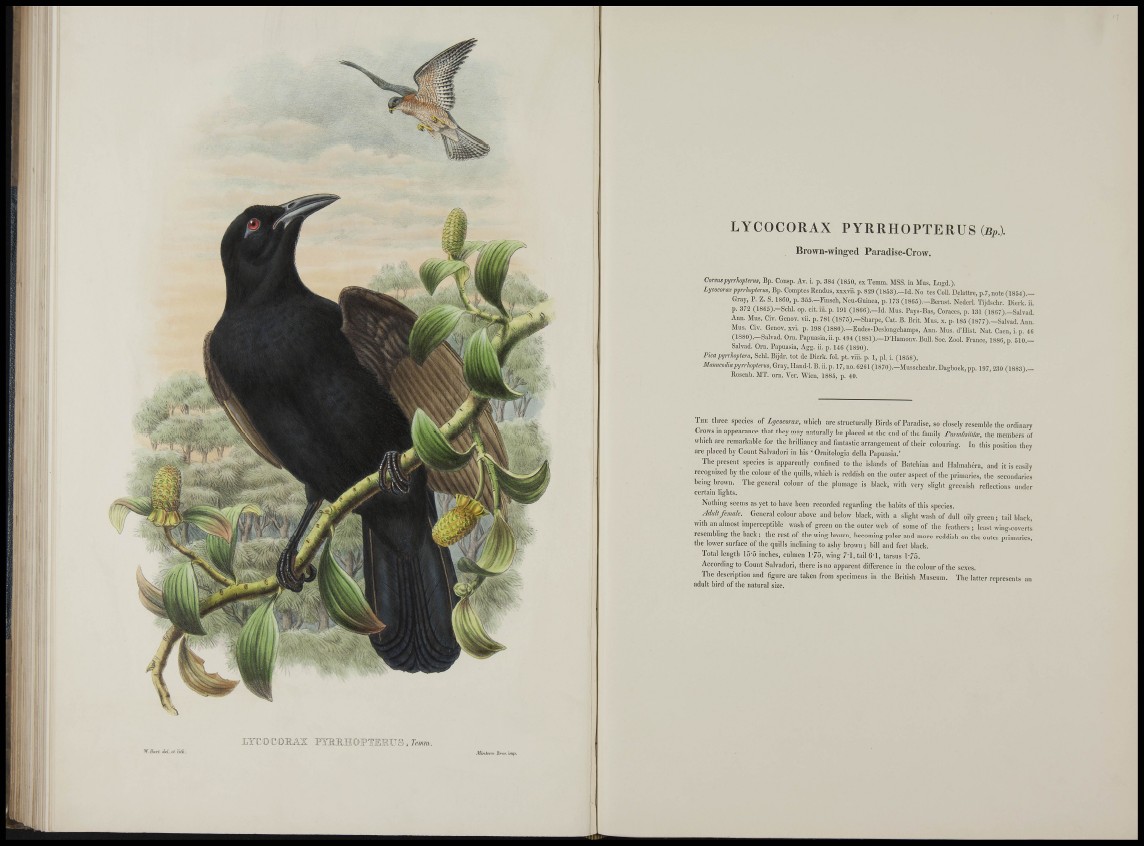
iSllll:
'•I?
e
'iiRi f
m
l i X O C O K A X PYHRHOPTIEKUS, 7>™h..
ir.H,„-i M.ct ml,.
LYCOCORAX PYRRHOPTERUS (Ui,.).
Brown-wing-ed Paradise-Crow.
Comispyrrhoplerus, Bp. Consp. Av. i. p. 384 (1850, ex Temm. MSS. in Mus. Lugd,).
Lycomrax pyrrhopierus, Ep. Comptes Rendus, xxxvii. p. 829 (1853) . - Id. No tes Coll. Delattre, p.7, note (1854).—
Gray, P. Z. S. 1800, p. SSS.-Finsch, Neu-Guinea, p. 173 (1865).—Bernst. Nederl. Tijdschr. Dlei-k. ¡¡.
p. 372 (1865).-Schl. op. cit. iii.p. 191 (186(i).-Id. Mus. Pays-Bas, Coraces, p. 131 (1807).-Salvad.
Ann. Mus. Ciy. Genov. yii. p. 781 (1875).—Sliarpe, Cat. B. Brit. Mus. x. p. 186 (1877).—Salvad. Ann.
Mus. Civ. Genov. xvi. p. 198 (1880).—Eudes-Deslongdiamps, Ann. Mus. d'Hist. Nat. Caen, i. p. 4C
(1880).—Salvad. Orn. Papuasia.ii. p. 494 (1881).—D'Hamonv. Bidl. Soc. Zool. France, 1886, p. 510.—
Salvad. Orn. Papuasia, Agg. ii. p. 146 (1890).
Pka pyrrhoptera, Schl. Bijdr. tôt de Dierk. fol. pt. viii. p. 1, pl. i. (1858).
Manucoâiapyrrlaptens, Gray, Hand-l. B. ii. p. 17, no. 6261 (1870).-Mussclienbr. Dagboek, pp. 197, 230 (1883).—
Rosenb. MT. orn. Ver. Wien, 1885, p. 40.
THE tliree species of ¿YCORO?-«^', vvliich are structurally Birds of Paradise, so closely resemble the ordinary
Crows ill a,,pearance tliat they may naturally be jilaced at the eiul of the family Paradmidm, the members of
«'Inch are remarlaible for the brilliancy and fantastic arrangement of their colouring. In this position they
are placed by Count Salvadori in his ' Oriiitologia della Piijiuasia.'
The present species is apparently confined to the islands of Batchian and Halmahera, and it is easily
recognized by the colour of the quills, which is reddish on the outer aspect of the iirimaries, the secondaries
being brown. The general colour of the plumage is black, with very slight greenish rellections under
certain lights.
Nothing seems as yet to have been recorded regarding the habits of this species.
Adult female. General colour above and below black, with a slight wash of dull oily green; tail black,
with an almost imperceptible wash of green on the outer ^vcb of some of the feathers ; least wing-covert¡
resembling the back; the rest of the wing brown, becoming paler and more reddish on the outer primaries,
the lower surface of the quills incliiiiiig to ashy brown ; bill and feet black.
Total length lo-5 inches, culmen 1-75, wing 7-1, tail G'l , tarsus l-7o.
According to Count Salvadori, there is no apparent difference in the colour of the sexes.
The descrii)tioii and figure arc taken from specimens in the British Museum. The latter represents an
adult bird of the natural size.